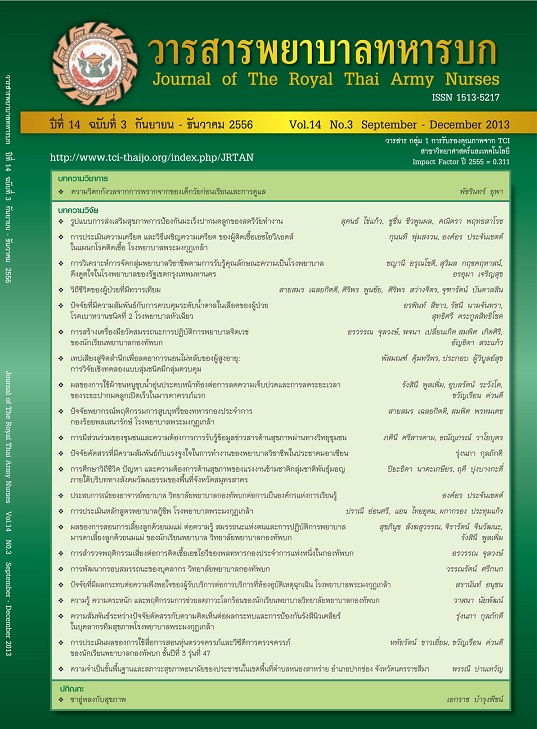ปัจจัยคัดสรรที่มีความสัมพันธ์กับแรงจูงใจในการทำงานของพยาบาลวิชาชีพในประชาคมอาเซียน The Relationship between Selected Factors and Nurse’s Motivations for Working in The ASEAN Community
Keywords:
แรงจูงใจ, ประชาคมอาเซียน, พยาบาลวิชาชีพ, ปัจจัยคัดสรร, แรงจูงใจในการทำงานของพยาบาลวิชาชีพในประชาคมอาเซียน, motivation, ASEAN, professional nurses, selected factors, motivation of nurses for working in the ASEAN CommunityAbstract
การวิจัยครั้งนี้เป็นการวิจัยเชิงพรรณนา (Descriptive research) มีวัตถุประสงค์เพื่อศึกษาแรงจูงใจในการทำงานของพยาบาลวิชาชีพในประชาคมอาเซียน และความสัมพันธ์ระหว่างปัจจัยคัดสรร ได้แก่ อายุ สถานภาพ ระดับรายได้ สถานที่ ปฏิบัติงาน ประสบการณ์ในการทำงาน ความสามารถในการใช้ภาษา การรับรู้ข่าวสาร และความรู้ด้านประชาคมอาเซียน กับ แรงจูงใจในการทำงานของพยาบาลวิชาชีพในประชาคมอาเซียน ประชากรที่ใช้ในการวิจัยเป็นพยาบาลวิชาชีพที่ปฏิบัติงานในโรงพยาบาลพระมงกุฎเกล้า จำนวน 800 คน ใช้การสุ่มตัวอย่างแบบตามสัดส่วน (Proportion to size) ได้กลุ่มตัวอย่างจากพยาบาลวิชาชีพโรงพยาบาลพระมงกุฎเกล้า 8 แผนก จำนวน 270 คน เครื่องมือที่ใช้เป็นแบบทดสอบ (Test) ความรู้ด้านประชาคมอาเซียน และแบบสอบถาม (Questionnaire) แรงจูงใจในการทำงานของพยาบาลวิชาชีพในประชาคมอาเซียน ที่ผู้วิจัยสร้างขึ้น และผ่านการตรวจความตรงตามเนื้อหา (content validity) จากผู้ทรงคุณวุฒิ 3 ท่าน และนำไปทดลองใช้ (try out) ได้ค่าความเชื่อมั่น
(reliability) ทั้งฉบับเท่ากับ .92 และ .90 ตามลำดับ วิเคราะห์ข้อมูลโดยหาค่าสัมประสิทธิ์สหสัมพันธ์ของเพียร์สันและ (chi-square)
ผลการวิจัยพบว่า ระดับแรงจูงใจในการทำงานของพยาบาลวิชาชีพในประชาคมอาเซียนอยู่ในระดับปานกลาง (2.85) โดย อายุ สถานภาพ ระดับรายได้ต่อเดือน สถานที่ปฏิบัติงาน ความสามารถในการใช้ภาษา ประสบการณ์ในการทำงาน และการรับรู้ข่าวสารมีความสัมพันธ์กับความคิดเห็นต่อแรงจูงใจในการไปทำงานในประชาคมอาเซียน อย่างมีนัยสำคัญทางสถิติที่ระดับ .05 และความรู้ในเรื่องของประชาคมอาเซียนมีความสัมพันธ์กันในทางบวกกับความคิดเห็นต่อแรงจูงใจในการทำงานในประชาคมอาเซียน
ในระดับปานกลาง (r = .153) อย่างมีนัยสำคัญทางสถิติที่ระดับ .05
This study was a correlation research. The objective was to investigate the level of motivation of nurses for working in the ASEAN Community and to determine the relationship between selected factors which were age, marital status, income level, workplace, work experience, foreign language ability, perception of related information, knowledge of the ASEAN Community and the nurse’s motivation for working in the ASEAN
Community. Material and method: Random sampling by proportion to size was used and 270 professional nurses in 8 departments of Phramongkutklao Hospital were included. We used questionnaire for collecting the data which evaluated validity by 3 experts. Then the instruments were distributed to professional nurses in 8 departments of Phramongkutklao Hospital. Instrument: Tools used in this study were the test of knowledge about The ASEAN Community (r = .92) and the opinion of nurse’s motivation for working in the ASEAN questionnaire (r = .90). The data was analyzed by Pearson product moment correlation coefficient and (chi-square).
Research findings revealed that the average of the motivation of working in the ASEAN community of the sampling mostly were at moderate level. The total mean score was 2.85. All selected factors which were age, marital status, income level per month, workplace foreign language ability, work experience, and perception of related information were significantly correlated with the motivation to work in The ASEAN
Community (Chi-square: 81.222, 568.296, 296.252, 91.185, 292.822, 87.719, 43.200 respectively) at the .05 level. Knowledge of the ASEAN community was positively correlated with the motivation to work in the ASEAN (r = .121), at the .05 level statistically significant.
Downloads
How to Cite
Issue
Section
License
บทความหรือข้อคิดเห็นใดใดที่ปรากฏในวารสารพยาบาลทหารบกเป็นวรรณกรรมของผู้เขียน ซึ่งบรรณาธิการหรือสมาคมพยาบาลทหารบก ไม่จำเป็นต้องเห็นด้วย
บทความที่ได้รับการตีพิมพ์เป็นลิขสิทธิ์ของวารสารพยาบาลทหารบก
The ideas and opinions expressed in the Journal of The Royal Thai Army Nurses are those of the authors and not necessarily those
of the editor or Royal Thai Army Nurses Association.





